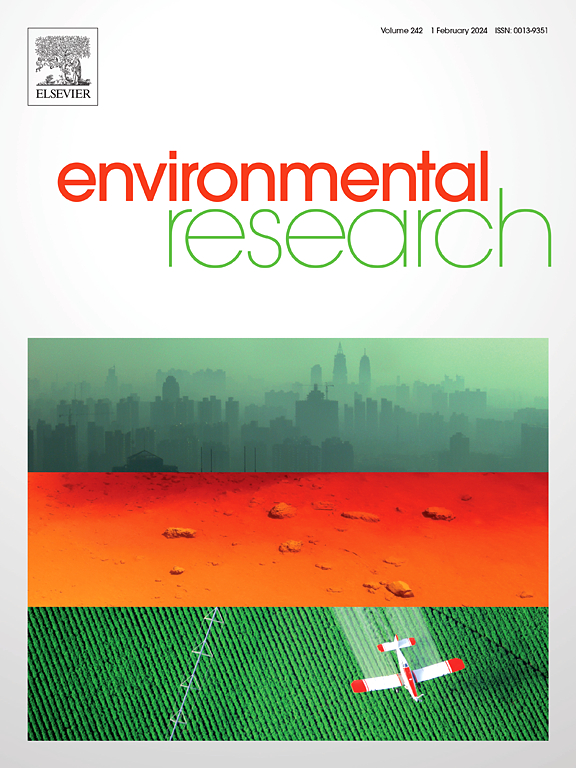Spatiotemporal evolution of small microplastics in agricultural soils from long-term pig manure application
IF 7.7
2区 环境科学与生态学
Q1 ENVIRONMENTAL SCIENCES
引用次数: 0
Abstract
Long-term application of organic fertilizers serves as a nutrient source in agriculture, yet the contamination of these materials with small microplastics (sMPs, 20–500 μm) remains poorly understood. Research on the accumulation and morphological transformation of sMPs in soils under extended fertilization regimes is currently scarce. This study employed Laser Direct Infrared (LDIR) Spectroscopy to quantify and characterize sMPs in soils subjected to four fertilization regimes: no fertilizer (CK), pig manure (M), nitrogen-phosphorus-potassium (NPK) fertilizer, and a combination of NPK and pig manure (MNPK). Temporal and spatial dynamics of sMPs were assessed across treatments with prolonged organic input. A progressive increase in both the abundance and type of sMPs was detected in pig manure, reaching 21,376 ± 1008 items kg−1 in 2023—an increase of 180 % compared to 1979.The initial soil sMPs concentrations in 1979 were approximately 3000 items kg−1; after 44 years, levels in M and MNPK treatments reached 7183 ± 568 items kg−1 and 5557 ± 329 items kg−1, respectively. Soils receiving pig manure consistently exhibited higher sMPs concentrations than untreated controls. The relatively elevated levels of sMPs suggest in-situ degradation of larger MPs. Except in the CK treatment, sMPs abundance increased with soil depth. Across all fertilization types, particles within the 30–100 μm range comprised over 46 % of total sMPs, indicating a consistent size distribution. The polymer types and composition in pig manure-amended soils mirrored those identified in the manure itself. These results demonstrate that long-term pig manure application markedly elevates soil sMPs concentrations, increasing the potential for sMPs contamination in agricultural systems.
长期施用猪粪对农业土壤中微塑料的时空演变
长期施用有机肥是农业的营养来源,但对这些材料受到小微塑料(sMPs, 20-500 μm)污染的了解甚少。目前对延长施肥条件下土壤中sMPs的积累和形态转化的研究很少。本研究采用激光直接红外光谱(LDIR)技术,对4种施肥方案(不施肥(CK)、猪粪施肥(M)、氮磷钾施肥(NPK)和氮磷钾与猪粪混合施肥(MNPK))下土壤中的sMPs进行了定量和表征。在长时间有机投入的处理中,对sMPs的时空动态进行了评估。猪粪中sMPs的丰度和类型都在逐渐增加,2023年达到21,376±1,008项kg-1,比1979年增加了180%。1979年土壤中sMPs的初始浓度约为3,000项kg-1;44年后,M和MNPK处理的含量分别达到7183±568和5557±329项kg-1。接受猪粪处理的土壤sMPs浓度始终高于未处理的对照。相对较高的sMPs水平表明较大的MPs在原位降解。除CK处理外,sMPs丰度随土壤深度增加而增加。在所有施肥类型中,30-100 μm范围内的颗粒占总sMPs的46%以上,表明大小分布一致。猪粪改良土壤中的聚合物类型和组成与粪便本身的聚合物类型和组成相一致。这些结果表明,长期施用猪粪显著提高了土壤中sMPs的浓度,增加了农业系统中sMPs污染的可能性。
本文章由计算机程序翻译,如有差异,请以英文原文为准。
求助全文
约1分钟内获得全文
求助全文
来源期刊

Environmental Research
环境科学-公共卫生、环境卫生与职业卫生
CiteScore
12.60
自引率
8.40%
发文量
2480
审稿时长
4.7 months
期刊介绍:
The Environmental Research journal presents a broad range of interdisciplinary research, focused on addressing worldwide environmental concerns and featuring innovative findings. Our publication strives to explore relevant anthropogenic issues across various environmental sectors, showcasing practical applications in real-life settings.
 求助内容:
求助内容: 应助结果提醒方式:
应助结果提醒方式:


